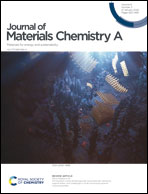Chemo-mechanical strain effects on band engineering of the TiO2 photocatalyst for increasing the water splitting activity†
Abstract
Photocatalytic water splitting is the most ideal system to harvest solar energy for the production of useful chemicals. There have been many attempts to increase the photocatalytic activity of the TiO2 photocatalyst, such as loading co-catalysts and dopants, and the introduction of oxygen vacancies. Strain effects have also attracted much interest to increase the charge mobility in bulk oxide. Here, we report on the effectiveness of tensile strain in stabilizing the anatase phase of TiO2 at high temperature and increasing the photocatalytic activity by an increase in the charge separation with a unique mixed phase structure. The rate of H2 formation over TiO2 was decreased upon spark plasma sintering (SPS) treatment because of a decrease in the surface area; however, SPS treatment with Au dispersion significantly increased the H2 formation rate to higher than that over commercially available P-25 TiO2 (no SPS treatment) loaded with Au. The O2 formation rate was also increased by strain effects in TiO2. Furthermore, strain effects were effective for visible light sensitivity on TiO2.



 Please wait while we load your content...
Please wait while we load your content...